For part 1 of the series, click here: How C V Raman came to Bangalore.
For part 2, click here: The Raman effect on IISc
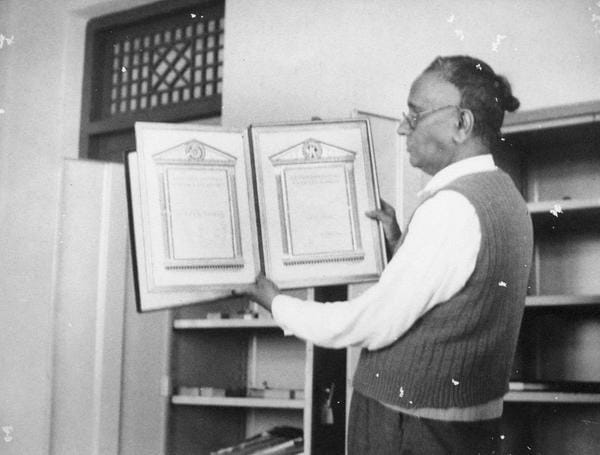
C V Raman with his Nobel prize. Pic courtesy: Raman Research Institute
While still serving as a professor at Indian Institute of Science (IISc), Raman had planned for a private institute where he could carry out research work on subjects that interested him personally, without having to go through a long and tedious procedure of getting approvals from a complex bureaucratic system at IISc. He had saved a considerable amount of money for this purpose from the dividends he received from two chemical industries in which he had invested and from the profits he had made on real-estate.
While on his lecture tours, Raman raised donations from many private patrons across the country. On one such occasion, when someone remarked it was not pleasant to see the greatest scientist of our country begging for money, Raman replied, “Our greatest men were beggars, take Buddha, Shankara or even Gandhi.”
The Maharaja of Mysore, who was known for his far-sightedness and patronage of science, gifted Raman 11 acres of land, located at a distance of a couple of minutes of walk from what is today known as Mekhri circle, to build the institution he wanted. The construction which began in 1943 was almost complete by the time of his retirement from IISc in 1948.
Research Institute of his dreams takes shape
The new institute was located adjacent to one of the four Kempegowda towers built in 19th century to mark the northernmost limits beyond which the city was not supposed to be expanded, for if it did, it was believed, ill-luck would descend upon the city.
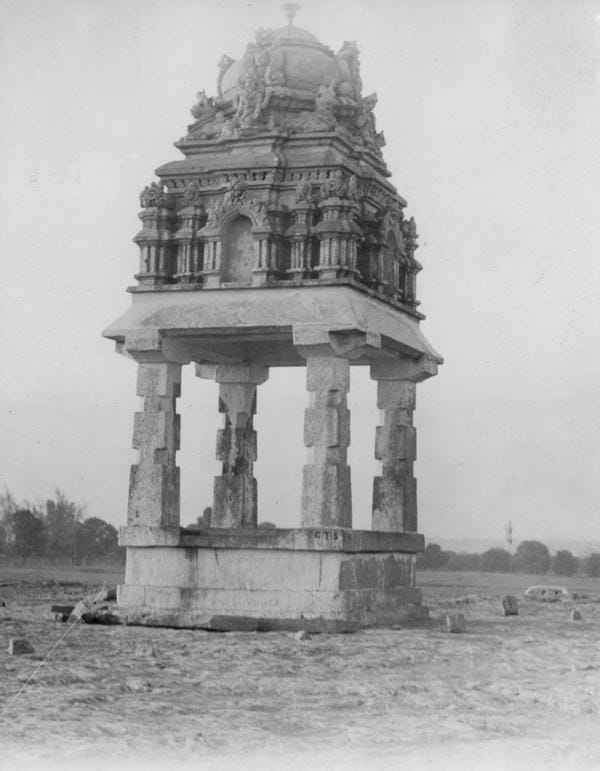 Kempegowda tower, now located in a park near Raman Research Institute. Pic courtesy: Raman Research Institute
Kempegowda tower, now located in a park near Raman Research Institute. Pic courtesy: Raman Research Institute
“The land on which Raman built”, in the words of A Jayaram, who wrote the book ‘C V Raman – A memoir‘, “sloped gently towards north and its soil was lateritic. The Kempegowda tower stands to the southeast on the lateritic hillock and the sun used to light it up in a blazing red. From this tower, you could see Nandi Hills 30 miles to the north. To the south lies Bangalore, cradled in a shallow valley. The adjoining area in those days was occupied by the beautiful palace gardens and lush agricultural fields.”
After raising barbed fence around the land, every inch of which was sacred to Raman, he took to afforestation, planting a variety of flowering trees, shrubbery and other trees that grew fast, under whose shade were laid walkways and stone benches. A two-storey building designed by Raman himself was the first building to be built on this land, facing north with its long side oriented along east-west. This was roofed with high ceilings facilitating continuous ventilation and dressed in light grey granite, which was always Raman’s preferred choice of stone for dressing up buildings. Those days they were available in plenty and were of high quality.
Lost in the beauty of the garden
Pillared verandas surrounded both the storeys that are connected by a granite staircase, large enough, as Raman used to remark, to allow a full-grown elephant to climb up to the first floor. The space in this building was judiciously utilised, providing rooms for laboratory, library, museum and bath. The Kempegowda tower could be seen from the eastern window of his reading room on first floor, which was paneled with teak wood and provided with glass cases for books and corner shelves for his collections of rare specimens. From the window to the south of this room, was the sight of palace gardens to behold.

Raman Research Institute during construction. Pic courtesy: Raman Research Institute
The pillared porch over the portico on the first floor was Raman’s favourite spot in the building, where he used to sit for long hours, gazing at the northern horizon where the well-defined outline of Nandi Hills, resembling that of a reposing bull, could be seen on a clear day.
To the east towered the building of Indian Institute of Science, the sight of which according to many accounts, was most unpleasant for Raman. He had rows of tall eucalyptus trees planted to block this view. Occasionally, when he used to get carried away by one of his fits of rage and resort to making vile remarks on the institute, a faint scent of eucalyptus wafting in the breeze blowing from east would soothe Raman, and he would change the subject and talk about how pleasing the fragrance was.
The eucalyptus trees planted by C V Raman have fully grown in RRI today, filling the campus with heady scent. Pic: Shree D N
Raman Research Institute begins functioning
It was by November of 1949 that the institute began functioning. Around this time Raman bought several microscopes, magnetrons, microwave generators, oscillators, transmitting equipment, servo-system, aerial cameras, optical systems, infra-red viewers and detectors, most of which were not in working condition, and also a liquid nitrogen plant, machine tools and lathes from Directorate General of Technical Development (DGTD) which had released the surpluses left behind by US army and air force during World War II for educational and research purposes. A carpentry and chemical lab was constructed to the west of the main building where lathes, machine tools and glass blowing technology were set up, and to its east, a Spectroscopic laboratory.
To the south of the darkened room on the west end of the main building where optical experiments were carried out, a heliostat – a device consisting of a mirror mounted on an axis pointing to the pole star – was set up on a pillared platform to throw a concentrated beam of reflected sunlight on to the specimen whose optical properties was being studied.
A heliostat is usually run by a clock mechanism to keep in step with the sun’s movement across the sky, but for the first two years of the institute when it had no supply of electricity, the mirror was rotated manually by a lab attendant, and Raman would signal him with a knock on the window when the angle of the mirror was suitable. Often, light on the specimen would suddenly disappear when the attendant stationed at the heliostat dozed off.
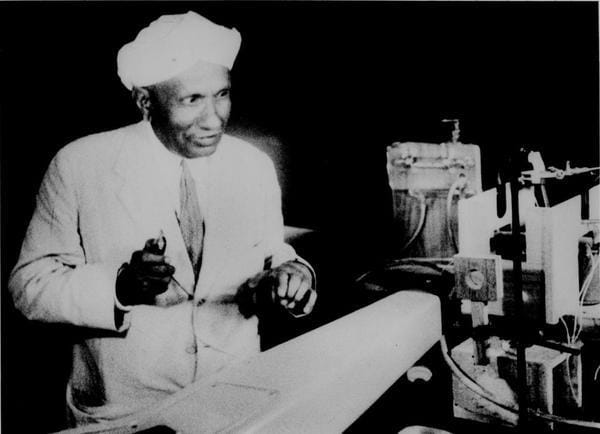
C V Raman with his spectroscope. Pic courtesy: Raman Research Institute
Work on optical characters of diamonds, gems
In this darkened room, Raman and his students would sit for hours with a beam of light, probing the optical phenomena exhibited by diamonds, gems, opals, feldspars, moonstones etc.
Jayram, describing the experience the students had with Raman in this room, wrote, “He would be looking at the sample with the sunlight shining on it and remark, ‘I say, you won’t believe what I see. It is a beautiful effect.’ Then after a while, ‘I think I see it, but, you know, it comes and goes’. The standard response of the bystander would be ‘Yes, sir’. (And after a few more observations), ‘I don’t think I was right in thinking that way. Now I don’t see it. I think I was very foolish to have mistaken that spurious effect for the real one.’ It would then be very awkward for the bystander to say ‘yes’, in case Raman was offended by (this confirmation). However, he need not have worried because Raman was only thinking aloud and what a bystander said was irrelevant to him at such times.”
A teetotaler, non-smoking gentleman
Raman’s style of administration was very personalised. He was a quick decision maker, and there was no secretary and no formalities that one had to go through in order to approach him. Anyone, including the gardener, who in fact received special treatment, could walk into his office whose door was always open. Any issues concerning the plants on the property received immediate and personal attention of Raman.
Raman was a teetotaler. In 1948, at a banquet held in Bordeaux in honour of Raman, when everyone on the table raised their glasses of sparkling wine to a toast proposed by French physicist Prof. Cabannes, Raman raised his glass of sparkling water to everyone’s amazement, saying, “Sir, I know what my effect on alcohol is, but I certainly don’t want to try the effect of alcohol on me,” and drank it to the toast. But his unwillingness to drink alcohol extended to much further extremes.
Once Jayaram drove Raman, who was suffering from a serious cough, to a nearby pharmacy and bought him a bottle of Waterbury’s compound, which was a common cough syrup in those days. On their way back in the car, Raman, while reading the label on the bottle, spotted ‘15% alcohol’ and said, “I say, this thing contains alcohol. I can’t take this medicine,” and handed it to Jayram, saying, “You can use it when you suffer from cough next time.” “..and I ended up with a bottle of Waterbury’s compound”, Jayaram recalls.
His aversion to smoking was so much that any of his students caught in the act were certain to face dire consequences. Dr. Lakhanpal remembers, Prof. Mahadevan, who was sitting with him in an open vehicle and relishing a cigarette, suddenly “ducked his head like an erring child, to avoid being seen by the great scientist”, when he saw the “turbaned face of Prof. Raman” in a car passing right beside them.
Prof G. Wentzel of Chicago University, who had come to visit Raman’s institute in 1952, lit a cigar in the museum while Raman was showing him around. As soon as he left, angry Raman said he would put up a “no smoking” board and would never again admit smokers into his museum.
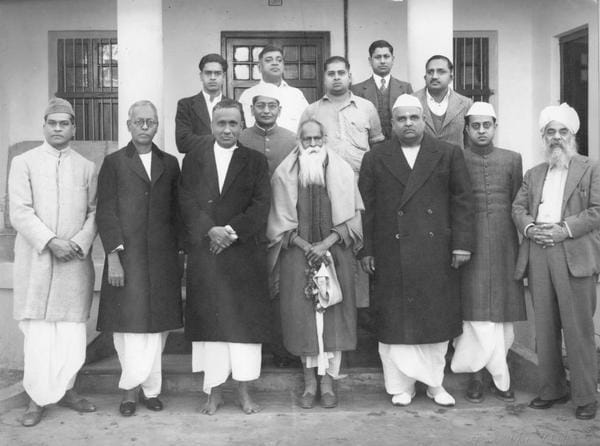
C V Raman with Acharya Vinoba Bhave, Social Activist. Pic courtesy: Raman Research Institute
Raman’s various ‘rasam’ habits
Being an early riser, Raman would always reach the institute before six O’clock in the morning, walking across Malleshwaram, taking a shortcut through the Sankey Road. His car would arrive later with a simple breakfast of Toast, banana and coffee packed by Lady Raman. He was a strict vegetarian and had a strong liking for south Indian food, particularly “rasam,” a word which he on many occasions used as a substitute for other words like “wonderful” or “brilliant”!
In spite of having many fine Swiss wrist-watches, Raman never wore them, and on those rare occasions when he did, the time shown was mostly wrong, for he never bothered winding it. Parthasarathy, his trusted driver, would look at his quarter century old watch, which had only the hour hand, and give Raman a correct estimation of time, to which his reply usually was, “Let us go. It is getting late”.
Gripped by the idea of becoming independent of his driver, Raman had once decided to start using a cycle instead. But after a few days Lady Raman forbade him from cycling, for Raman, lost in his own thoughts, would often veer off into the wrong side of traffic and find himself in dangerous situations.
On Raman’s request, the Mysore Maharaja granted him four more acres of land to the south east of the institute, where Raman built for himself a single-storeyed villa, again dressed in granite, facing a garden to the south, where the finest of roses available in the Bangalore nurseries were planted. A drive-in portico made of granite was built on the northern side, gilded with a pergola of violet and yellow flowering creepers. From his bedroom on the eastern end of the house could be seen the Kempegowda tower standing on a red hill, and on the western side, walkways were laid out with flowering shrubs on either side.
For weekend retreat, Raman would leave the institute on Saturday afternoons with Lady Raman, and drive to the bungalow on his 100 acres estate in Kengeri, surrounded by agricultural lands and forest grooves, with a narrow stream flowing along the southwestern perimeter of the property.
Reaching on time, he would walk up to a particular spot on a high land to watch the sunset. Being fascinated by the iridescent colours of butterfly wings, on the origin of which he wrote a scientific paper, the 65-year-old Raman would run after them in the estate, swinging a netted bag to catch them and bring them to the institute in a jar. Padmanabhan, one of Raman’s students, would mount them in a glass case after treating suitably to preserve the colours. Many of these mounted butterflies are even today arranged on the shelves of the museum in Raman Research Institute.
Gems and crystal specimens
 C V Raman explaining scattering of light in a crystal. Pic courtesy: Raman Research Institute
C V Raman explaining scattering of light in a crystal. Pic courtesy: Raman Research Institute
E K Govindaraj, a well known photographer in Bangalore and a man of fine artistic taste, who was hired to assist Raman in designing the museum, installed in the teakwood cases built by carpenters, under his personal supervision, shelves made of glass plates to display Raman’s collection of gems, quartz, calcites and other crystals acquired from all over the globe. Raman spent hours placing the specimens in different positions, trying different intensity and angles of lighting, to ensure its beauty was displayed in full measure.
The most colourful and dazzling crystals were displayed in the corner room of the museum with front and side lighting, while the larger mineral specimens, which were polished to distinctly reveal their colours and intricate patterns, were arranged on the shelves cantilevered to the walls in the long room. Bright green willemite, red calcites, blue fluorspar and multicoloured franklinite from New Jersey glowed in different colours in a small darkened room under UV lights.
Another room was reserved for display of mounted butterflies, beetles, stuffed birds, iridescent shells and nacre. Many of these specimens can still be seen on visiting the museum at Raman Research Institute.
Discovering uniqueness of Veena
Today at the museum, a tabla and Lady Raman’s veena is kept for display. Raman’s love for music was so profound that he took to studying the physics and mathematics behind the sounds produced by various instruments and wrote volumes of scientific papers on the subject. When a string stretched on an instrument is plucked, it produces not only one note having a fundamental frequency, but also higher notes. And musical harmony is achieved when the frequency of higher notes are multiples of the fundamental frequency, that is to say, in the ratio 1:2:3:4:..
But the overtones of most string instruments are in the ratio 1:3:5, with 2 and 4 always missing, in accordance with the acoustical principles laid down by Helmontz. But Veena and Tanpura, Raman discovered, are two unique instruments of undated antiquity that violate Young-Helmontz law and produce harmonic sounds that are much richer in quality and much more pleasing to the ear, because of the slight curve on the bridge, unlike the bridges of western string instruments that are flat.
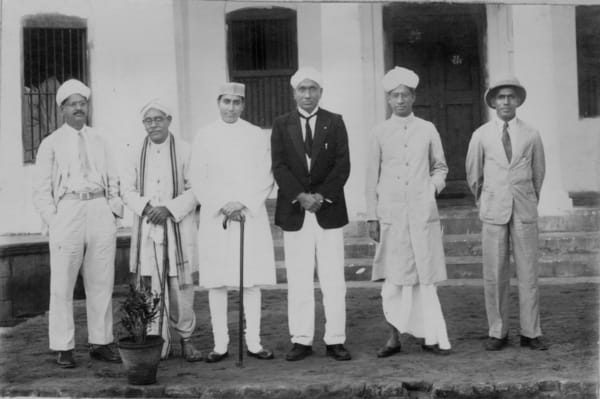
C V Raman with Birbal Sahni (3rd from left) and Sarvapalli Radhakrishnan (5th from left) Pic courtesy: Raman Research Institute
It was common knowledge in his time that the circular stretched membranes of percussion instruments cannot produce harmonic overtones. But Raman, on noticing the soothing sound of Tabla and Mridangam, experimented with these drums, tapping at the antinodes and restraining the motion of the drumhead by applying gentle constraints at suitable points with his fingertips; and demonstrated, from the patterns formed by the lycopodium powder dusted on the excited membrane, that these drums did in fact produce harmonic overtones because of the partial loading of the drum membrane with a firmly adherent paste.
Diamonds attract Raman
Just before joining Raman for research work in Calcutta, his brother C Ramaswamy got married and was presented a diamond ring by his father-in-law. Fascinated by its clarity and scintillation, Raman ordered the spectrum of scattered light from that particular diamond to be recorded, and in the process, strong vibrational line characteristic of diamond lattice was recorded for the first time. A scientific paper on diamond’s exhibition of blue fluorescence under ultra-violet light was written, marking the beginning of Raman’s life-long romance with diamonds.
Over 600 diamonds of different kinds and origins, displaying different colours of luminescence – red, blue, green and other intermediate colours – made its way into Raman’s collection: some received as gifts, others bought at auctions after careful examination. As Raman was known to be an expert, many brought diamonds to the institute to have it examined by Raman before buying.
The 63 diamonds studded on the pendant with which Raman was decorated in 1933, when he was honoured with the title “Rajyasabhabhushana” by the Mysore Maharaja, were promptly brought to the lab, where its luminescence characteristics were carefully studied to arrive at several conclusions about the nature and intensity of luminescence exhibited by diamonds when excited by ultra-violet light.
One tabular diamond which Raman referred as “My Kohinoor”, exhibited a blue fluorescence that was bright enough to light up a small room, when a concentrated beam of sunlight, filtered using Wood’s glass which allows only the ultraviolet rays to pass through, was made to fall on it. The diamond collection were kept safely under lock, and only selected visitors had the privilege of the beholding the spectacle.
References:
- C. V. Raman : A Biography by Uma Parameswaran
- C. V. Raman – A Memoir by A. Jayaram
- Journey into Light by G. Venkataraman
- C.V. Raman – A Pictorial Biography By Prof. Ramasheshan
- Conversations of the reporter with Mrs. Ramasheshan
For Part IV, click here: Raman’s meeting with Nehru and more
Related Articles
How C V Raman came to Bangalore
The Raman Effect on Indian Institute of Science
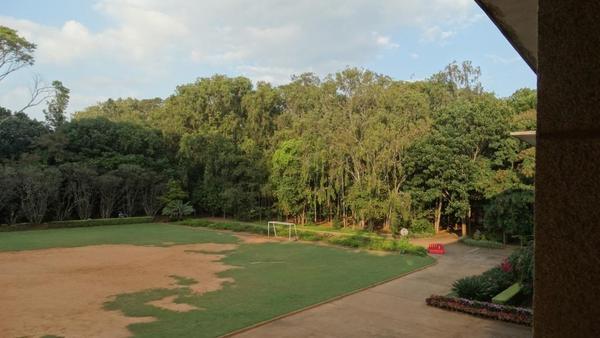
excellent article! nice gems of insight into a great man’s life